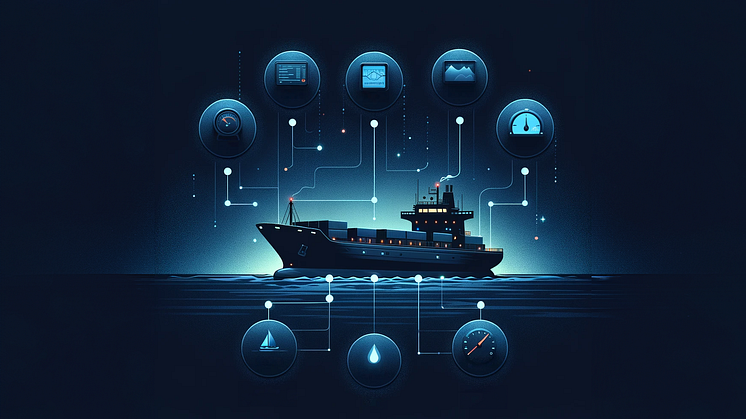
News -
Are you not the owner of your marine operations data? An unfortunate reality of Maritime Business.
Ethan Faghani
CEO and Founder of Cetasol
ethan.faghani@cetasol.com
January 15, 2024
The question we ask all our customers revolves around ownership of data. It is not uncommon that maritime operators are not the owners of their data but rather owned by a specific supplier. Other times the operator doesn’t know who the owner of the data is. Our work in Cetasol starts when we have data. To get this data we need access to basic information, real-time data, and sensor information.
There is a difference between owning the data and seeing it. You can be the owner of your data but have an external company, like ours, come in and access the data, transfer it, and easily understand it with no extra cost than initially specified.
Commercial Marine Analogy
If you are new to the maritime market, consider this analogy:
Imagine you want to make your own sports car. You start by ordering the metal body from a workshop, designing it yourself, or choosing based on catalog designs. Next, you buy the engine and mechanical parts from different suppliers and an integrator will put it all together for you. The same integrator probably integrates the electronics as well. All the components are from different brands, and some are connected but most stand-alone.
Now you are going to race with your car. To improve the racing, you need to be able to measure. But wait a minute, the system is not designed to be measured. In general, people think about mechanical or electrical connections but not always about data flow.
Different operators take different actions here, we will discuss it further in this article.

The Challenge
I come from the truck transportation segment and have learned a lot from marine since 2015. I often wonder: Is it a technical challenge?
Most operators that we talk to have control over their mechanical and even electrical (to a lesser degree) connections. Usually, you can see mechanical and electrical drawings. However, when it comes to data, an essential part of improvement, most operators are not in control of their data.
Why is it important?
Without measurement, improvement is difficult, if not impossible
We see two types of challenges with different digital maturity.
Most customers are starting their digitalization journey and are in the process of getting control of their data. They usually have limited data, manual processes, and stand-alone systems. The second group of customers, usually larger fleet owners, have made good progress in their digitalization and added and connected many sensors. However, they face a problem of data overload. This issue might be recognizable in your daily life by getting too many notifications on your cell phone. You will not have time to read all, and after a while, you do not care when important items will be hidden from your eyes over time. It seems like the second group and the first group have the same issue after all: lack of insights.
Data is a gold mine, but someone must dig in to find the gold.
In marine, isolated data pools are common. Most of the time the technology being used for data ports is outdated and non-standard. The suppliers do not pay much attention to creating a data connection portal due to a lack of demand and sometimes knowledge from the end customers. “Data blocking” is another issue where the suppliers do not share their data.
Where to start?
There are two layers of challenges here 1) what to do with existing systems and 2) how to think from now on.
A workshop
Do not start with what you have, start with what you need. Start with what data is most critical for your operation. The importance of data might be different for different departments. Start by identifying the most critical data for your operations, involving various departments to prioritize needs. You need to involve selected members of the IT, engineering department, crew, finance, and management team.
As you see there is no limit to how many data points (signals) you need. However, we strongly recommend going with the 80-20 rule.
20% of the signals provide 80% of the value.
Signal Mapping to Values
The outcome of prioritizing data should be a ranked list of signals, their sources and a link to their value or service.
Signal Mapping to Available Systems
The outcome of prioritizing data should be a ranked list of signals, their sources, and a link to their value or service.

Create a Data Pipeline Drawing
You need to create a data pipeline drawing, like an electrical or mechanical drawing for all the vessels and at the organizational level. This document should be live and updated regularly, maintaining simplicity.
Evaluate the Technical Debt
Technical debt is the gap between what you need and what you have, including the necessary modification of existing components/systems. Since many of the existing systems might not provide the information in the format or quality that you need, then you need to consider that in your calculations as well.
Technical dept are both in terms of finances and time.
It is important to highlight the technical debt in your management team or even in the balance sheet. This is a liability that your company will pay one way or another.
Synched Quality Components
When you are buying new components or asking to modify the existing components or systems, it is important to bring them to the level that is accessible. Here we want to introduce the concept of “Synched Qualified”.
What is the issue? Imagine you have a laptop, and instead of USB-C, you have two wires hanging on the side of the system (a port). You do not know what it is, what protocol it is, or what signals are in that port, even if you read the signals you need to translate 0 and 1s to something understandable.
A synched qualified component should fulfill all the requirements below.
1. Dedicated Port: Should have at least one dedicated port for connection to the system.
2. Standard Protocols: Should have a standard protocol. We strongly recommend NMEA2000, CANBUS J1939, CANBUS, MODBUS TCP.
3. Data Sample: Each component should submit a data sample (data dump) together with the delivery of the system.
4. Translation file: We strongly recommend asking for a translation file. The translation file should cover mapping internal signal names to required signals with necessary protocol specifications.
5. Data Quality Sample: The supplier should also provide a sample of their signals. Sample signal quality should be gathered in environments as close as possible to the operational environment ( on a vessel or a hardware-in-loop rig)
6. Complete Signals: This is harder to define, but as a rule of thumb we recommend looking at the component as a black box and defining inputs, outputs, and characteristic signals. Inputs and outputs are connected to other systems and characteristic signals (curves or parameters) are the most important parameters that define that component in terms of performance and maintenance. For an engine, for example, inputs RPM and load, outputs power characteristics of fuel consumption, boost pressure, and exhaust temperature. More signals are better but this can be a minimum from the component.
7. Updates: All points mentioned above have to be updated with the update of the system.
8. Add it to the Contract: Make sure this is properly added. Talk to your legal advisor so you are the legal owner of your data.

If you are asking for a modification of an existing system, the list above needs to be considered as well.
We encourage all the operators to ensure their components are “Synched Qualified”.
Avoid Extra Technical Debt
It is important to avoid adding extra technical debts from now on.
- Avoid purchasing systems that are not “synched.”
- Modify the current systems to “synched” quality.
- Update the data pipeline drawing with changes in the components.
Soft Aspects of Digitalization
Data-driven operation is not a product that you can buy or a service with an endpoint. It is a culture and a continuous practice.
You will need a team buy-in, so ensure it is not a management idea only. We recommend getting a full team commitment on the digitalization journey. The cases that have full team commitment typically move much smoother.
How many sensors do I need?
This will be discussed extensively in a separate article. We see vessels in the market with over 100 main signals and major one-time costs to connect to sensors. Although this might be needed in some cases, most cases will receive the most values from a few initial sensors.

How much data should I expect from suppliers?
This was discussed briefly in Synched part, item 5. Modern control units might have over 1000 internal parameters. Typically, these are not of interest. You might need only inputs, outputs, and most importantly characteristic signals.
A word with suppliers: Are you part of the solution or part of the problem?
Liberating data will add value to your offers. Many years ago, if someone had a good family recipe for cookies, they tried to keep it a secret. Today you see many sharing their secret recipe on YouTube, but why? You get more value by showing the expertise rather than that specific recipe.
The issue is not generally about keeping the data secret, but rather suppliers see that as an extra cost, a cost that may be unnecessary to take. With changes coming in the marine segment, it will be more and more difficult to install a component without proper connection possibilities to another segment. There is a technical debt and a hidden extra cost in your cost of sales.
Connected Operators
We talked about the operators that have already taken major steps in connecting components and subsegments. For those customers with gigs of data, the next level is an AI analysis tool to create actionable insights.
Modern and Electrical Drivelines
You might think that more modern systems or electrical drivelines are easier to connect to. This is technically correct but not always in practice. We have seen many cases where new suppliers tend to dream about the value creation by holding data. The value is in creating insights not the data by itself.
We also have seen more electric vessels where connections are non-standard, low quality, and trouble accessing. This is mainly because, despite diesel engine manufacturers (larger companies with decades of experience), the electric drivelines can be integrated by smaller companies where they might not pay attention to creating standard connections. We will discuss this in a separate article.
Final Words
It is up to the operators to demand standard port and quality data to build their digitalization solutions.
If you are interested in pushing the “Synched Qualified” concept more, please register here. We will call for an online workshop to support the operators. We help you evaluate if your data is “synched qualified”.
If you think this article was useful, please register for our newsletter for the latest updates and announcements of new articles. Get the newsletter here.

About Me
Ethan Faghani is the CEO and founder of Cetasol. Before Cetasol, Ethan was Chief Engineer of Automation and AI at Volvo Penta. Ethan has experience working with cutting-edge technologies in other transportation segments in both big enterprises and his own founded startup. Ethan obtained his Ph.D. in mechatronics from UBC and Innovation and Entrepreneurship from Stanford Business School.






